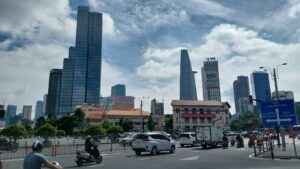Vietnam looks to 2025 for southern industrial property growth

Southern provinces report stable Q3, but developers push plans into 2025 in the face of economic headwinds
Despite a challenging 2024 marked by global economic uncertainties and regulatory changes, southern Vietnam’s industrial property market is poised for a robust recovery in 2025. Investors are increasingly optimistic about the region’s potential, driven by a combination of strategic location, infrastructure development, and a growing demand for industrial space.
While 2024 has seen a cautious approach from investors due to external factors, there are encouraging signs of resilience. The supply of both factories and warehouse has continued to increase, with total supply rising by 2% quarter-on-quarter (approximately 92,000 sqm) for RBF and 3% quarter-on-quarter (approximately 174,400 sqm) for RBW. This expansion has been accompanied by a marginal increase in asking rents, indicating growing confidence in the market’s long-term prospects.
“It is positive to see continued construction of ready-built factories, enhancing occupiers’ choice when considering Vietnam as a destination to start or expand operations. Landlords are competing with each other which invariably creates a good environment for occupiers and encourages growth. The range of product now available is significant and includes developments with environmental accreditation which bring Vietnam more aligned into global supply chain requirements,” said Alex Crane, Managing Director of Knight Frank Vietnam.
“The warehouse market has faced some challenges due to increased supply and lower absorption, however we believe the overall outlook in the mid-to-long term for industrial property in southern Vietnam remains positive as higher quality buildings are available at relatively affordable prices. Much of the warehouse market here is dependent on export demand and local consumer growth. Our house view is that with 2024 elections out of the way in much of the world, particularly in the US, we might have a clearer flight path for export need in 2025 and thus more demand for warehousing in the south of Vietnam,” Crane added.
The industrial park sector has also shown signs of growth, with net absorption reaching 83 hectares in Q3 2024, a 14.7% increase quarter-on-quarter but a 36.6% decrease year-on-year. Key provinces like Long An, Ba Ria-Vung Tau, and Binh Duong have emerged as hotspots for investment, attracting businesses from various industries. The development of new industrial parks, such as the upcoming Nam Tan Tap IP in Long An, is expected to further enhance the region’s appeal to investors. Looking ahead to 2025, the market is anticipated to experience a significant rebound. The completion of delayed projects, coupled with increased investor confidence, is expected to drive demand for industrial space. The region’s strategic location, infrastructure improvements, and favorable government policies will continue to play a crucial role in attracting foreign direct investment and fostering economic growth.

 Xem Tiếng Việt
Xem Tiếng Việt 

